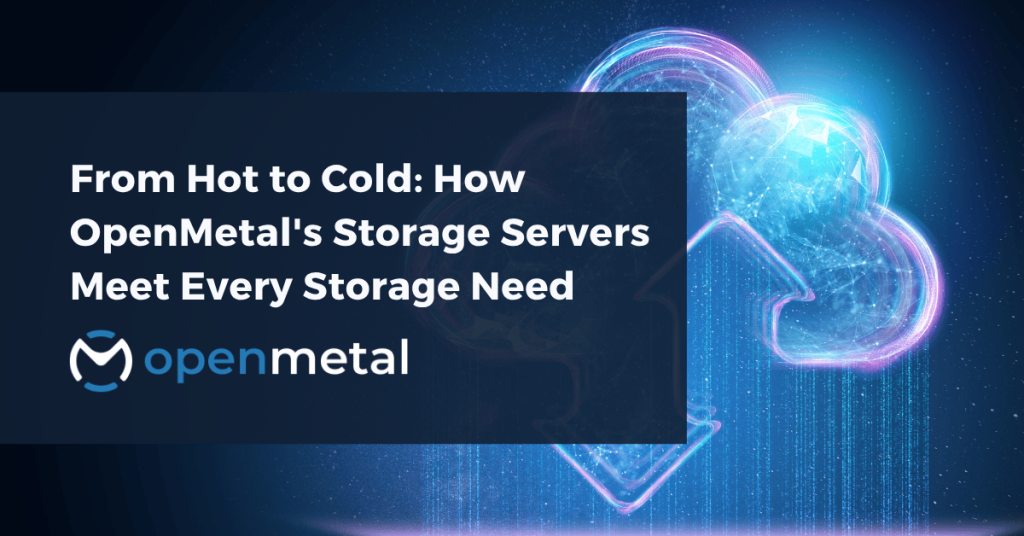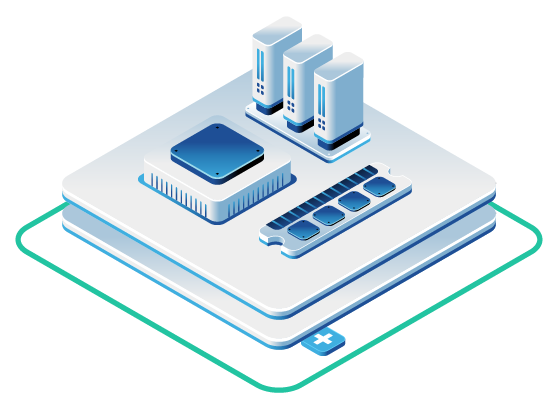
Ready to simplify your storage infrastructure?
The OpenMetal team is standing by to assist you with scoping out a fixed-cost model based infrastructure plan to fit your team’s requirements, budgets, and timelines.
Key Takeaways
- Hybrid storage architecture combines NVMe SSDs and high-capacity HDDs in the same servers, delivering both high performance and cost-efficient capacity without forcing you to choose between speed and affordability.
- Ceph provides unified block, file, and object storage under one system, eliminating the complexity of managing separate storage platforms for different workload types.
- Predictable egress pricing using 95th-percentile bandwidth billing removes the surprise costs associated with cold storage retrieval, making data recovery and migration events affordable and transparent.
- OpenMetal’s storage servers scale from hundreds of terabytes to multi-petabyte deployments, supporting diverse use cases including backups, AI pipelines, media archives, and data lakes with consistent performance and transparent costs.
- Open-source foundation ensures no vendor lock-in, giving you root-level control to customize replication policies, tiering strategies, and storage workflows as your requirements evolve.
Modern data doesn’t fit into neat categories. Some of it demands microsecond access times and ultra-low latency. Other data sits quietly for months, waiting to be retrieved for compliance audits or analytics jobs. Most organizations manage both extremes simultaneously — along with everything in between. The challenge isn’t just storing data anymore; it’s storing the right data on the right infrastructure at the right cost.
Traditional cloud storage approaches force you into binary decisions: hot or cold, fast or cheap, performance or capacity. But your workloads don’t operate in binaries. You need infrastructure that adapts to the full spectrum of storage demands without forcing you to juggle multiple vendors, APIs, or unpredictable pricing models.
OpenMetal’s storage servers eliminate those tradeoffs. Built on open-source Ceph and powered by hybrid NVMe and HDD architectures, these systems deliver a unified storage platform that handles everything from latency-sensitive databases to multi-petabyte archives — all within a single, transparent infrastructure.
Hot, Warm, and Cold: Understanding the Storage Spectrum
Before diving into architecture, it’s worth clarifying what we mean by storage tiers, because the terminology can be confusing.
Hot storage refers to data that’s frequently accessed and requires immediate, low-latency retrieval. Think transactional databases, real-time analytics, AI model training datasets, or live application data. This tier prioritizes speed above all else and typically relies on NVMe SSDs to deliver sub-millisecond response times and high IOPS.
Warm storage sits in the middle. It’s data you need regularly but not constantly — perhaps older logs, infrequently queried datasets, or staging areas for batch processing. Performance matters, but absolute speed is less important than cost-efficiency. This tier often uses a blend of flash and spinning disks to balance accessibility with affordability.
Cold storage is for data that’s rarely accessed but must be retained — backups, compliance archives, historical records, or media libraries. Here, capacity and durability take precedence over speed. Cold storage lives on high-capacity HDDs, where the cost per terabyte is dramatically lower, and retrieval times measured in seconds rather than microseconds are acceptable.
The problem with most storage solutions is they treat these tiers as separate systems. Hot data goes to one vendor’s all-flash array. Cold data gets shipped to an object storage service with its own API and pricing structure. Warm data? You figure it out. The result is fragmented infrastructure, operational complexity, and unpredictable costs.
OpenMetal takes a different approach: one unified system that spans the entire storage spectrum.
Inside OpenMetal’s Hybrid Storage Architecture
OpenMetal’s storage servers are purpose-built to handle the full range of storage demands using a hybrid architecture that combines NVMe SSDs and high-capacity HDDs in a single chassis.
Take the Storage Server Large v3 as an example. Each server includes 12 × 18 TB enterprise HDDs, delivering 216 TB of raw capacity per node. That’s paired with 4 × 4 TB Micron 7540 MAX NVMe drives (16 TB total) that serve as high-speed caching, journaling, and metadata layers. When you deploy three of these servers in a cluster, you’re looking at 648 TB of HDD capacity and 48 TB of NVMe flash, all working together under Ceph’s distributed storage system.
The newer Storage Server Large v4 takes this even further. It packs 12 × 22 TB HDDs (264 TB raw per server) alongside 4 × 6.4 TB Micron 7450 MAX NVMe SSDs (25.6 TB total). A three-node cluster delivers 792 TB of HDD storage and 76.8 TB of NVMe cache, powered by dual Intel Xeon Silver 4510 processors with 48 cores and 96 threads per server.
What makes this architecture powerful isn’t just the hardware specs — it’s how the components work together. The NVMe layer accelerates journaling, caching, and metadata operations, ensuring that even HDD-backed storage feels responsive. Meanwhile, the high-capacity HDDs provide cost-effective bulk storage for datasets that don’t need sub-millisecond latency.
This hybrid design means you’re not forced to choose between speed and capacity. You get both, in the same system, managed through the same interface.
Ceph and Unified Storage: One System for Block, File, and Object
At the heart of OpenMetal’s storage infrastructure is Ceph, the open-source distributed storage system that unifies block storage, file storage, and object storage within a single cluster.
Ceph’s architecture is built around Object Storage Daemons (OSDs) that manage individual drives across the cluster. When you write data to a Ceph cluster, it’s automatically distributed and replicated across multiple OSDs, ensuring durability and fault tolerance. If a drive fails, Ceph reconstructs the missing data from other replicas without downtime or data loss.
For block storage, Ceph provides RBD (RADOS Block Device) volumes that integrate seamlessly with OpenStack Cinder, allowing you to provision virtual machine volumes with different performance characteristics. Want a high-IOPS volume for a database? Map it to an NVMe-backed Ceph pool. Need bulk storage for a file server? Use an HDD-backed pool instead.
For object storage, Ceph’s RADOS Gateway (RGW) exposes an S3-compatible API, making it drop-in compatible with applications already designed for cloud object storage. You can store backups, media files, or data lake contents using standard S3 tools and libraries, but the data lives on your own infrastructure with no egress fees.
File storage? Ceph supports that too through CephFS, a POSIX-compliant distributed file system that scales horizontally as you add storage nodes.
This unified approach means you’re not managing separate storage systems for different workloads. One Ceph cluster, one set of management tools, one consistent experience — whether you’re provisioning block volumes for VMs, uploading objects to a data lake, or mounting shared file systems.
And because Ceph is open source, you’re not locked into proprietary APIs or vendor-specific tools. You have full root-level control to tune replication policies, adjust tiering strategies, or implement custom workflows without waiting for a vendor to support your use case.
Cold Storage That Doesn’t Feel Cold
One of the biggest misconceptions about cold storage is that it has to be slow. In reality, cold storage just needs to be cost-optimized — but it doesn’t have to sacrifice accessibility.
OpenMetal’s hybrid storage architecture proves this point. Even when data lives on HDDs, the NVMe layer accelerates critical operations like metadata lookups, write-ahead logging, and frequently accessed blocks. Ceph’s intelligent caching ensures that recently accessed data gets promoted to faster tiers automatically, while infrequently used data ages out to HDDs.
For truly massive cold storage deployments, OpenMetal deploys dedicated object storage clusters using erasure coding instead of replication. In a typical configuration, data is split into 17 data chunks plus 3 parity chunks (17+3 erasure coding). This scheme tolerates up to three simultaneous drive or node failures while using only 17.6% storage overhead — compared to 200% overhead for triple replication.
A 20-node cluster built on Storage Server Large v4 hardware can deliver approximately 2.7 PiB of usable object storage capacity. That’s enough to store years of security camera footage, petabytes of scientific datasets, or entire media archives — all accessible via standard S3 APIs and protected against multiple concurrent failures.
The result is cold storage that behaves more like warm storage. You’re not waiting minutes for data to be retrieved from tape or deep archive tiers. You’re getting sub-second access to objects stored on cost-optimized HDDs, with the NVMe layer ensuring metadata operations stay fast even as your dataset grows into the petabyte range.
Predictable Egress Pricing and Transparent Costs
Public cloud storage pricing looks simple until you start retrieving data. Suddenly you’re paying per-GB egress fees, per-request charges, and early deletion penalties. A backup restore or data migration can generate five-figure bills that weren’t in the budget.
OpenMetal eliminates this unpredictability with a 95th-percentile bandwidth pricing model. Instead of charging per gigabyte transferred, OpenMetal measures your bandwidth usage over the billing period, discards the top 5% of spikes (to account for legitimate bursts), and bills based on the 95th percentile.
What does this mean in practice? If you need to restore a multi-terabyte backup or migrate data between regions, you’re not hit with surprise per-GB fees. Your bandwidth costs remain predictable and tied to sustained usage patterns rather than one-time events.
This pricing model is especially valuable for cold storage workloads where retrieval patterns are unpredictable. Compliance audits, disaster recovery tests, and data science projects often require pulling terabytes of archived data on short notice. With OpenMetal, those events don’t blow up your cloud bill.
The transparency extends beyond bandwidth. There are no hidden costs for API requests, no minimum storage durations, and no penalties for deleting data. You pay for the infrastructure you provision and the bandwidth you consistently use — nothing more.
Real-World Use Cases: Backup, AI, and Archive
Different workloads have different storage requirements. OpenMetal’s hybrid architecture adapts to all of them.
Backup and Disaster Recovery
Backup storage is the classic cold storage use case, but modern backup requirements demand more than just cheap capacity. You need fast initial ingest to minimize backup windows, reasonable recovery times when restores are needed, and the flexibility to keep multiple retention tiers.
OpenMetal’s hybrid servers handle this naturally. The NVMe layer accelerates backup ingest, especially for incremental backups that require metadata lookups and deduplication checks. The HDD tier provides cost-effective long-term retention for full backups and archives. And because everything runs on Ceph with erasure coding or replication, your backups are protected against hardware failures without requiring secondary backup copies.
AI and Machine Learning Pipelines
AI workloads create a unique storage challenge. Model training requires high-throughput access to massive datasets — often hundreds of terabytes or more. But once training is complete, those datasets become cold storage until the next training run.
OpenMetal’s storage clusters excel in this scenario. During active training, data can be staged on NVMe-backed pools for maximum throughput. Between training runs, datasets age to HDD-backed pools, freeing up fast storage for other workloads. And because Ceph supports both S3 object storage and block volumes, data scientists can use whichever interface fits their workflow — PyTorch DataLoaders reading from S3, or high-speed block volumes mounted directly to GPU compute nodes.
Media Archives and Content Libraries
Media production generates enormous amounts of data — raw camera footage, intermediate renders, and final deliverables. Most of it needs to be retained indefinitely for future reuse or legal compliance, but only a fraction is actively accessed at any given time.
OpenMetal’s object storage clusters are ideal for media archives. Content can be stored as S3 objects with arbitrary metadata for search and discovery. The hybrid architecture ensures that even multi-gigabyte video files can be retrieved quickly when needed, while the HDD-backed storage keeps costs manageable even for petabyte-scale archives.
Data Lakes and Analytics Platforms
Modern analytics platforms need to ingest data from dozens or hundreds of sources, store it in raw form for future analysis, and make it queryable without complex ETL pipelines. This is the data lake model, and it requires massive, cost-effective object storage.
OpenMetal’s Ceph-based object storage provides S3-compatible data lakes with predictable costs and performance. Data scientists and analysts can query datasets using tools like Apache Spark, Presto, or DuckDB, all reading directly from S3-compatible object storage. And because the storage is on-premises or in your own colocation facility, there’s no egress cost for moving data between storage and compute — a major advantage over public cloud data lakes where cross-service bandwidth can get expensive fast.
The Future of Unified Storage Infrastructure
The trend in storage is clear: consolidation. Organizations are tired of managing separate systems for block, file, and object storage. They’re done with unpredictable cloud bills and vendor lock-in. And they’re increasingly interested in open-source solutions that give them control without sacrificing enterprise features.
OpenMetal’s storage servers represent this future. By combining Ceph’s unified storage architecture with hybrid NVMe and HDD hardware, OpenMetal delivers a single platform that handles everything from hot databases to cold archives. The result is simpler operations, predictable costs, and the flexibility to tune performance and capacity independently as workloads evolve.
As data volumes continue to grow — driven by AI, IoT, video, and other data-intensive applications — the ability to manage storage efficiently across the full hot-to-cold spectrum becomes a competitive advantage. Organizations that can store massive datasets cost-effectively while maintaining fast access to active data will move faster than those stuck with fragmented, expensive storage silos.
OpenMetal’s approach isn’t about replacing all your storage with one monolithic system. It’s about giving you the foundation to build storage infrastructure that adapts to your workloads instead of forcing your workloads to adapt to storage limitations.
Talk to OpenMetal’s team about building a unified storage platform that handles your entire data lifecycle — from hot databases to cold archives — with predictable costs and zero vendor lock-in.
FAQ
What’s the difference between using OpenMetal’s storage servers versus public cloud object storage?
The primary differences are cost predictability and control. Public cloud object storage charges per-GB egress fees that can make data retrieval expensive and unpredictable. OpenMetal uses 95th-percentile bandwidth pricing, so backup restores or data migrations don’t generate surprise bills. You also get root-level access to customize Ceph configurations, replication policies, and tiering strategies — flexibility that’s impossible with managed cloud services.
Can I mix hot and cold data in the same storage cluster?
Absolutely. That’s one of the key advantages of OpenMetal’s hybrid architecture. Ceph allows you to create separate storage pools backed by different media types — NVMe pools for hot, latency-sensitive data and HDD pools for cold, capacity-focused workloads. Both pools exist in the same cluster and are managed through the same interface. You can even configure Ceph to automatically tier data between pools based on access patterns.
How does erasure coding compare to replication for cold storage?
Erasure coding is far more storage-efficient than replication while maintaining similar durability. OpenMetal’s 17+3 erasure coding scheme uses only 17.6% storage overhead compared to 200% overhead for triple replication. This means you can store significantly more data in the same physical footprint. The tradeoff is slightly higher computational overhead during writes and reconstructions, but for cold storage workloads where capacity matters more than write latency, erasure coding delivers better economics without sacrificing data protection.
What happens if a storage server fails in my cluster?
Ceph is designed to handle hardware failures transparently. If a storage server fails, Ceph automatically reconstructs missing data from replicas (in replicated pools) or from surviving erasure-coded chunks (in erasure-coded pools) on other nodes. Your applications continue accessing data without interruption. Once you replace the failed hardware, Ceph rebalances data across the cluster automatically. With proper replication or erasure coding configured, you can tolerate multiple simultaneous failures without data loss or downtime.
Can OpenMetal storage integrate with existing applications that use S3 APIs?
Yes. Ceph’s RADOS Gateway (RGW) provides S3-compatible object storage, making it drop-in compatible with applications already designed for AWS S3 or other S3-compatible services. You can use standard S3 SDKs, CLI tools, and libraries without modification. This means backup applications, data lake platforms, media workflows, and analytics tools that expect S3 storage can work directly with OpenMetal’s infrastructure — but without the egress fees and with full control over your data.
Read More Blog Posts


































